Meet the
Burmese
Cat
History of the Breed
The Burmese cat breed was developed in 1930 from a cat named ‘Wong Mau’. Wong Mau was brought back from Asia to San Francisco where she was given to Dr Joseph Thompson. Thompson bred Wong Mau with a seal point Siamese cat with the aim to produce a breed that had her distinguishing brown coat, and compact but dainty body similar to that of a Siamese cat. Wong Mau was then bred with her son again to lay the foundations of the breed. By 1954 the Cat Fanciers Association officially recognised the Burmese cat as a breed. This was after previously recognising the breed but then suspending breed recognition.
In the UK by 1952 breeders had successfully produced several generations of true Burmese cats. The International Cat Association officially recognised the breed in June 1979.
The Burmese cat breed was developed in 1930 from a cat named ‘Wong Mau’. Wong Mau was brought back from Asia to San Francisco where she was given to Dr Joseph Thompson. Thompson bred Wong Mau with a seal point Siamese cat with the aim to produce a breed that had her distinguishing brown coat, and compact but dainty body similar to that of a Siamese cat. Wong Mau was then bred with her son again to lay the foundations of the breed. By 1954 the Cat Fanciers Association officially recognised the Burmese cat as a breed. This was after previously recognising the breed but then suspending breed recognition.
In the UK by 1952 breeders had successfully produced several generations of true Burmese cats. The International Cat Association officially recognised the breed in June 1979.
What Defines a Burmese?
The Burmese is a medium-sized cat but when you pick them up, they feel considerably heavier than they appears. They are a stocky cat and somewhat compact but is very muscular with heavy boning.
The Burmese is a cat that is round all over. The head is round, the tips of the ears are round, the eyes, chin and even the feet are round. This breed is solid both in looks and in feel and has great strength.
The coat of the Burmese is short and glossy. Darker shading on the points may be seen in kittens, but this shading disappears with age, producing richness in any of the accepted colors.
While the accepted colors for Burmese have increased in the past few years, the vast majority of Burmese are still the traditional deep brown (Seal).
Behaviour
Burmese cats are very friendly, sweet natured cats who thrive off attention. This cat is known for being vocal much like their Siamese cousins, however their voice is softer. Burmese cats can be attention seeking and will become lonely if left by themselves for too long. This is a great pet for a family as they get along brilliantly with children and are very tolerant. These cats are full of character and life with them will never be dull.
Personality
Younger Burmese are active, curious cats, and adapt easily to changes. However as they get older, some Burmese can become a bit too placid, preferring to watch rather to get involved in activities.
At any age, they love to look at the world around them and their favorite place may often turn out to be a window where they can observe the world outside. Burmese cats are very comfortable with other Burmese, but they may not get along as well with other breeds.
They're good climbers and jumpers and should have cat trees and perches. They're a sturdy, stocky cat and their nutrition should be watched to prevent obesity, particularly if the cat does not get enough exercise.
While adult Burmese are placid cats, they also tend to be very kittenish and love their daily playtime. They love being adored by their parent, and love having their stomach rubbed and being petted. A daily petting session is a must for any Burmese.
Colours
Burmese exist as either solid colours or tortie. Colours include Seal (Brown), Blue, Cream, Chocolate, Lilac, and Red
Colours - From Seal to Russet
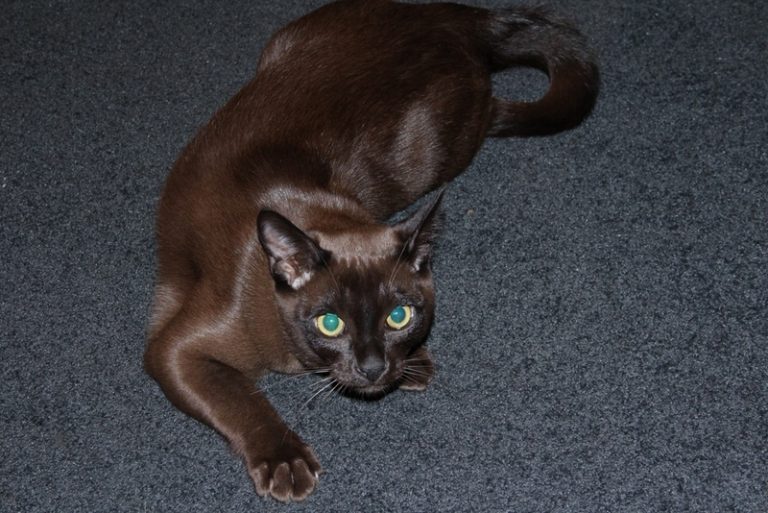
Seal (Brown/Sable)
A Seal Burmese cat has a rich, warm dark brown coat, resembling the color of a seal’s fur—hence the name. The fur is evenly colored, sleek, and glossy, with a satin-like texture. As they mature, their coat may develop a slightly lighter tone on the underside. Their eyes are typically a striking golden yellow to amber, providing a beautiful contrast to their deep brown fur.
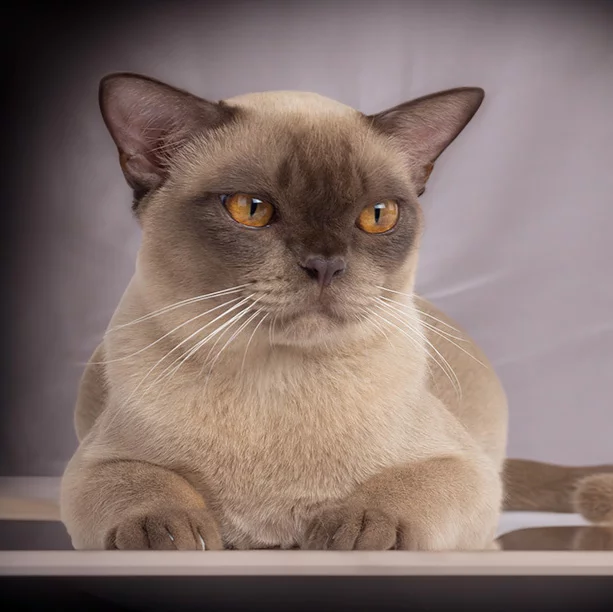
Chocolate
A Chocolate Burmese cat has a warm, milk chocolate-brown coat that is lighter than the Seal Burmese. The fur is evenly toned, smooth, and glossy, with a luxurious satin-like texture. The face, ears, and tail may appear slightly darker, while the underside is often a shade lighter. Their eyes are a stunning golden yellow to amber, creating a beautiful contrast against their soft chocolate-toned coat.
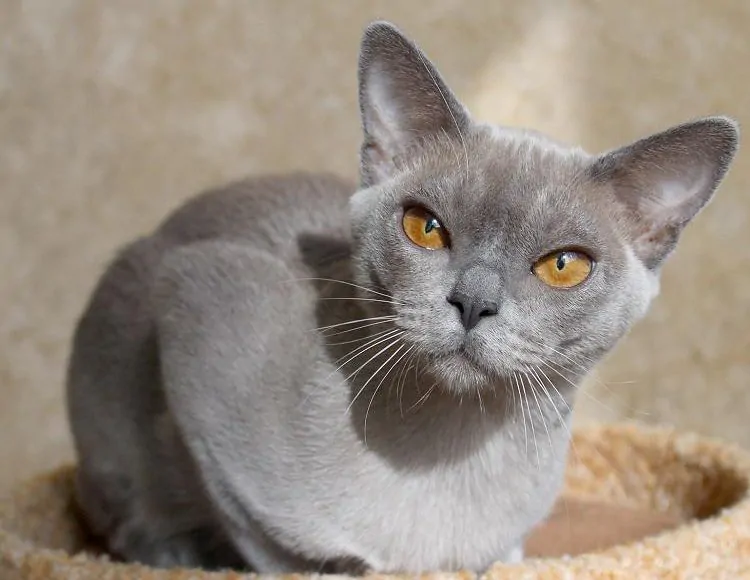
Blue
A Blue Burmese cat has a soft, silvery-blue coat with a subtle warm undertone. The fur is short, sleek, and satin-like, giving it a luxurious sheen. The color is evenly distributed, though the face, ears, and tail may appear slightly darker. The underbelly is often a touch lighter, creating a gentle contrast. Their eyes are a striking golden yellow to amber, standing out beautifully against the cool blue tones of their coat.
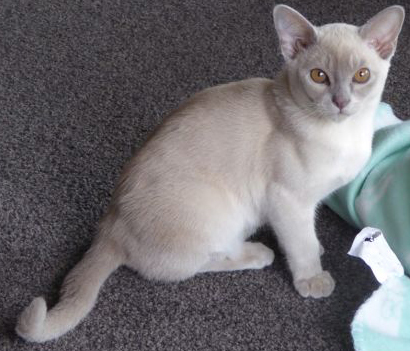
Lilac
A Lilac Burmese cat has a soft, frosty dove-grey coat with a warm, pinkish-lavender undertone. The fur is short, sleek, and satin-like, giving it a beautiful, subtle sheen. The color is evenly distributed, though the face, ears, and tail may appear slightly deeper in tone. The underbelly is often a shade lighter, creating a gentle contrast. Their eyes are a stunning golden yellow to amber, standing out beautifully against the delicate lilac tones of their coat.
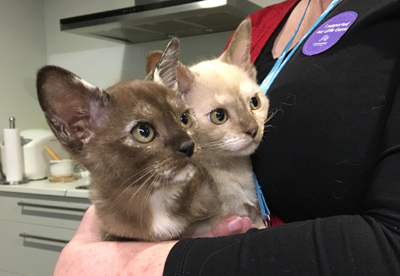
Torties
A Tortie Burmese cat (Tortoiseshell Burmese) has a striking mottled mix of two colors, blending shades of seal, chocolate, blue, lilac, red, or cream in a unique, random pattern. No two Torties are exactly alike. Their fur is short, sleek, and satin-like, giving them a glossy, luxurious appearance. The distribution of colors varies, with some having bold patches while others have a more subtle, marbled blend. Their eyes are a captivating golden yellow to amber, beautifully complementing the rich variety of tones in their coat. (Pictured is a Seal Tortie and a Chocolate Tortie
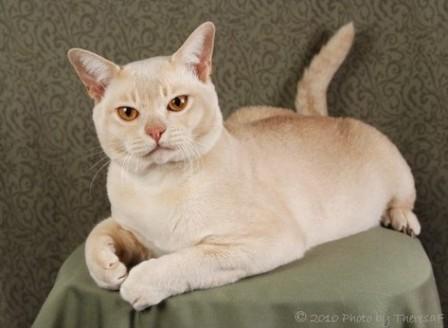
Cream
A Cream Burmese cat has a soft, pale cream to warm honey-colored coat with subtle apricot undertones. The fur is short, sleek, and satin-like, giving it a smooth, glossy finish. The color is evenly distributed, though the face, ears, and tail may appear slightly deeper in tone. The underbelly is often a shade lighter, creating a delicate contrast. Their eyes are a stunning golden yellow to amber, adding warmth and depth to their gentle cream-colored coat.
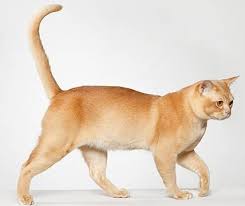
Red
A Red Burmese cat has a warm, rich apricot to deep tangerine coat with subtle golden undertones. The fur is short, sleek, and satin-like, giving it a soft, glossy finish. The color is evenly distributed, but the face, ears, and tail may appear slightly deeper in tone. The underbelly is often a lighter, creamy shade, creating a gentle contrast. Their eyes are a striking golden yellow to amber, beautifully complementing their warm-toned coat.
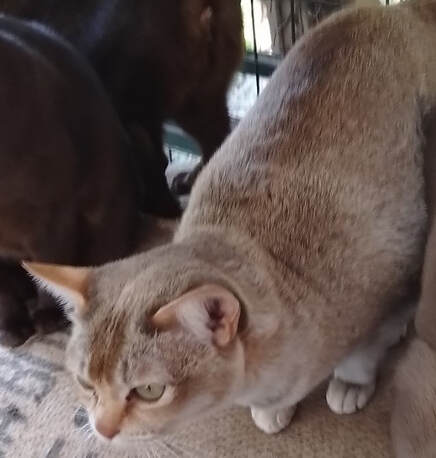
Russet
A Russet Burmese has a unique and striking coat that changes color as it matures. Kittens are born with a rich dark brown or reddish-brown coat, similar to a Seal Burmese, but as they grow, their fur gradually lightens to a warm, reddish-orange hue. This distinctive transformation is due to a rare genetic mutation found in Burmese cats bred in New Zealand. The fur remains sleek, short, and satin-like, with an even tone across the body. Their golden yellow to amber eyes beautifully complement their fiery russet coat, making them one of the most visually striking Burmese varieties.
The New Zealand Cat Fancy Breed Standard
What Is a Breed Standard?
A breed standard is a written guide that describes what the ideal cat of a particular breed should look and behave like. It’s used by breeders and cat show judges to help make sure the breed stays healthy, recognisable, and true to its unique characteristics.
It covers things like:
• ✨ Appearance – body shape, size, coat length, colour, eye shape, ear placement, etc.
• 🧠 Personality – typical temperament and behaviour of the breed
• 💎 Uniqueness – what sets this breed apart from others
Think of it as a “blueprint” or “wishlist” for what the breed should be; but remember, not every cat is a perfect match (and that’s okay!). Breed standards help maintain quality and consistency in breeding, and ensure fairness in competitions.
Prefer to read? You can access the official PDF directly.
Prefer to listen? We’ve created an audio version that discusses the content in a more conversational format. Choose what works best for you!